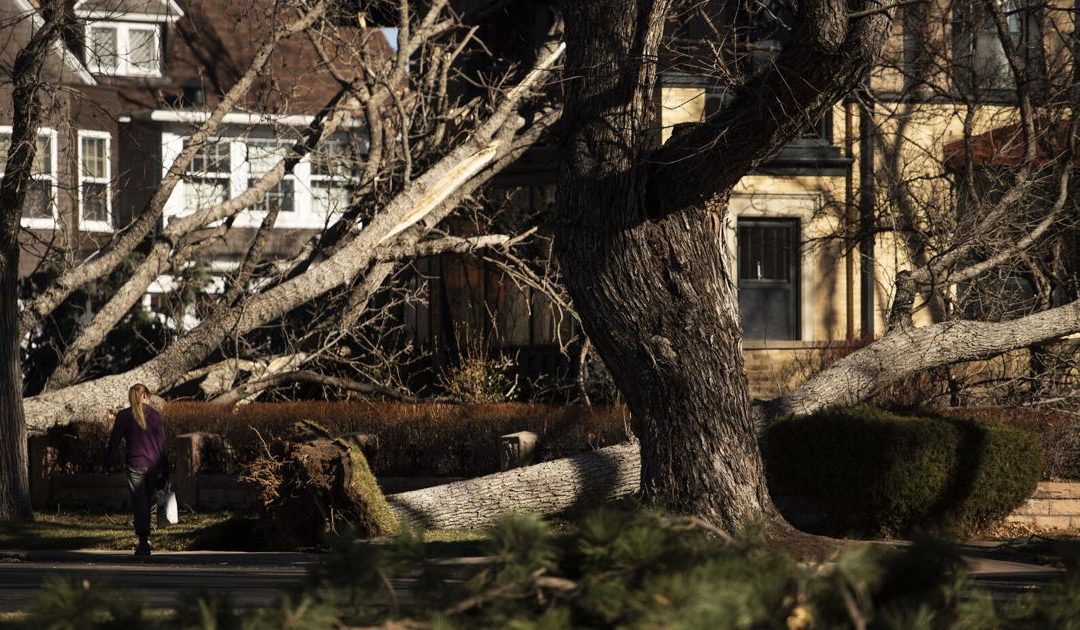Cleaning up after hurricane-force winds tore up Colorado Springs — pushing over mature trees, downing fences and cutting power — is in some ways just getting started a week after the storm swept through.
Colorado Springs city crews were still removing trees blocking streets Tuesday and the work to clean up damaged public trees is likely to stretch on for months, City Forester Dennis Will said.
“We will be at this for months,” he said.
Street crews, who would normally be clearing snow from the roads this time of year, jumped into help with the initial tree cleanup and some department members will likely be working on street sign replacement for the next 30 days, said Clint Brown, street operations manager.
Colorado Springs Utilities workers were restoring power to the last few homes Tuesday after electricity was knocked out to 47,000 customers at the peak of the outage and winds destroyed 97 utility poles, data from Utilities showed.
Utilities staff expect to review the event closely to see if they could have managed it better, in part, because they expect extreme weather events to become more frequent, CEO Aram Benyamin said.
“We are going to have these kinds of things more and more,” he said. Nationally, climate change is expected to drive more frequent extreme weather.
While Utilities was prepared for the storm, it exceeded expectations by downing two reinforced high voltage lines, the backbones of the grid, that are designed to withstand high winds, he said. The loss of the high voltage lines didn’t cause outages because one main line remained functional, he said.
“We were hanging off of one contingency,” Benyamin said.
The best way to prevent power outages is to put electric lines underground and about 70% of the local grid is already buried. Utilities has budgeted $10 million this year and next year to put lines underground. But it is an expensive process, and an ongoing project to bury lines downtown is budgeted to need $6 million, Benyamin said. He would like to slowly increase the budget to bury power lines annually and eventually have the entire local grid underground.
He also acknowledged that residents who would like Utilities to provide accurate estimates about when power could be restored to their homes after an outage are making a fair request, he said.
He would like to see Utilities get to a point where the staff can provide those estimates. It’s a step that will require technology that provides Utilities staff with information from the field about the condition of infrastructure so they can assess damage and the repair process can be streamlined.
For example, drones could provide footage from the field that would allow staff to see damage to a pole and power line, prioritize it and make sure the correct parts are delivered to the site for repair crews, Benyamin said. Such a process could eliminate the need for on-the-ground assessments and help the repair process go much more quickly.
Now that power has been restored to most residents, downed city trees are likely a common post-storm concern, particularly in older parts of town such as Patty Jewett, Old Colorado City and the Old North End.
City operations and maintenance got 200 phone calls in the first two hours of the storm about damage, including downed trees in roadways, said Brown, who oversees a department of about 140 people who jumped in to help.
The calls were so overwhelming crews went street by street to clear the roads, he said.
Once all streets are clear, city forestry will move on to trees that are in imminent danger of failure and pose a safety risk, Will said.
He urged residents to examine their trees for hanging limbs, cracks in the trunk and around the soil because the city could see more wind soon that could cause more damage, he said.
“We don’t want anybody getting hurt,” he said.
The department has about 400 pending requests for help and needs to take care of trees on homes, so he urged patience, Will said. The city will take care of damage from trees that fell from the right of way, typically the area between the street and the sidewalk.
“If people want to wait, it’s our responsibility. We’ll clean it all up,” he said.
In addition to the extreme wind, dry conditions likely played a role in the level of destruction to trees the city saw. In 2017, the extreme wind storm brought down far more tree limbs compared to the storm last week that blew over trees 40 to 50 inches in diameter, Will said.
The trees may have toppled because soils don’t have any moisture to give them cohesive properties and the root balls weight, he said.
Other factors also played a role. Colorado blue spruce, ponderosa pine and juniper trees were likely some of the common casualties because they don’t thrive in the clay soils that are predominate in town. Some trees planted close to homes also did not have enough space for their root systems to grow in all directions and bear the load, Will said.
“I think it’s a lot to do with the wrong tree in the wrong place,” he said.
To report public damage caused by the storm, visit coloradosprings.gov/page/citizen-request-gocosprings-app.
This content was originally published here.

